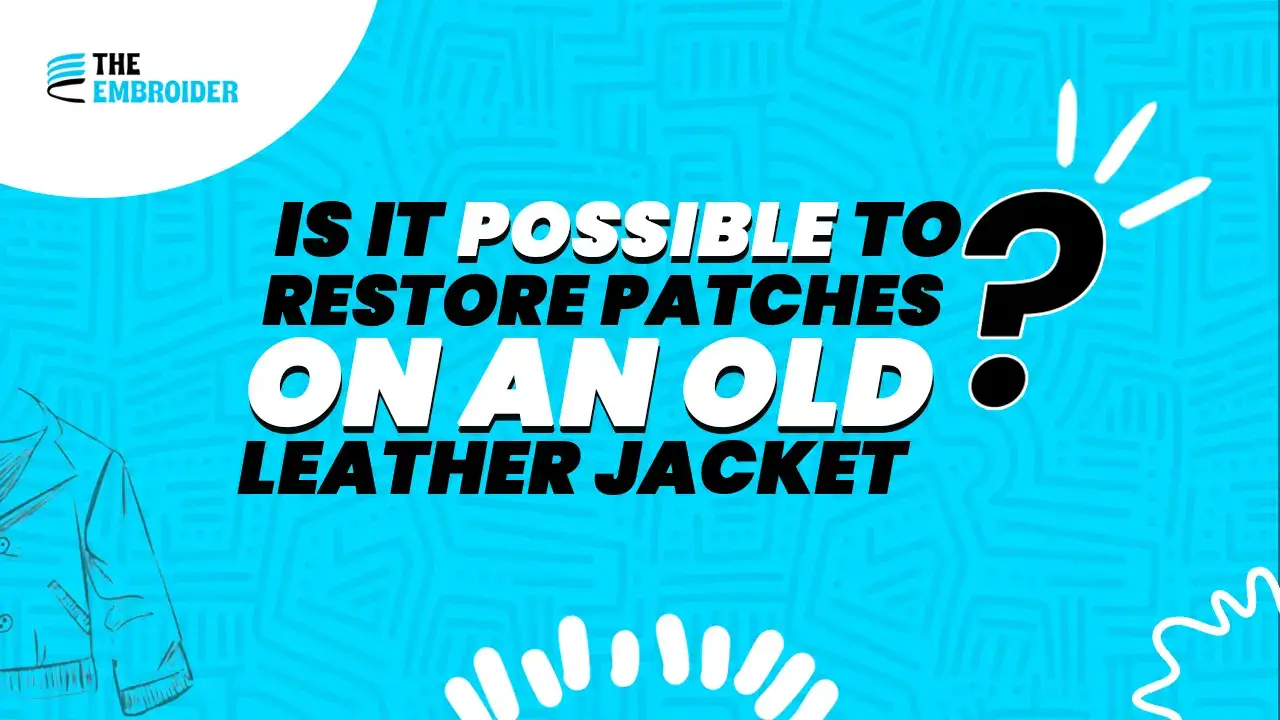Yes you absolutely can bring patches back to life on an old leather jacket. They might fade, peel, or fray with time, but with some care and the right fixes, those patches can look good again without losing the jacket’s soul.
Here’s something that shows it’s not just us who care: the leather goods repair market is already worth billions, which tells me people would rather restore than toss something they love.
In this guide, I’ll walk you through how to restore patches on an old leather jacket whether it’s a woven patch, chenille, or a bold 3D embroidered patch so your jacket can look great again without losing its soul.
1. Assess the Patch Situation
Start by examining each patch in daylight:
- Peeling edges → glue or re-stitch
- Faded colors → textile paint or fabric markers
- Fraying threads → reinforce the border
If your patch is an embroidered custom patch, check for loose stitches early before they unravel further.
2. Clean Around the Patch
Dirt, body oils, even skin residue will weaken adhesives and threads. Use:
- A soft cloth
- A leather-safe cleaner
- A soft brush
Gently clean the area, don’t saturate it. To avoid harsh chemicals they strip away the leather’s natural oils. (This is something leather sustainability groups often warn against.)
Keeping the leather in good condition lets your patches last longer.
3. Reattach Loose or Peeling Edges
If a patch is coming loose:
- Fabric glue: Apply under edges, press down, and give it time to set.
- Low-heat iron-on: If the patch was originally heat-applied, place a thin cloth over it and press lightly (only if the leather can take it to test a hidden area first).
Never press directly on the leather without a cloth. Doing so risks scorch marks or warping.
According to The Leather Working Group (authority on sustainable leather), keeping leather clean and conditioned extends its lifespan significantly.
4. Revive Faded Colors
Faded patches can often come back to life:
- Match the original colors as closely as possible
- Test in a hidden area first
- Use light, controlled strokes to fill in fading
For detailed elements, fabric markers give you more control than a brush.
5. Condition the Leather
Patches only look good when the leather around them is healthy:
- Apply a good leather conditioner with a lint-free cloth
- Rub in gentle circles around (not on) the patch
- Let it absorb for at least an hour
Doing this every 3–4 months helps prevent cracking, stiffening, or patch detachment.
6. Reinforce with Stitching
In places that take a lot of strain like sleeves, shoulders, or the back it’s smart to add extra stitches:
- Use a leather needle so you don’t accidentally tear the material
- Pick a tough thread that blends in with your patch
- Go with simple, strong stitches running stitch or blanket stitch do the job well
- If you’re unsure, practice first on a scrap piece before stitching your jacket
7. Final Check & Touch-Ups
After everything’s dried:
- Inspect all edges and corners
- Fix any missed spots
- Trim stray threads
- Even out color where needed
A little attention now prevents big problems later.
When to Call a Pro
If patches or leather are too deteriorated, or if your jacket has high sentimental or monetary value, a leather expert can:
- Replace damaged patches
- Professionally dye and match faded areas
- Reinforce seams in high-stress spots
Extra Tips for Longevity
- Keep your jacket away from prolonged water exposure
- Hang it on a solid hanger to maintain shape
- Recondition the leather regularly
- Avoid storing it in direct sunlight or heat
Wrap-Up
Restoring patches on an old leather jacket isn’t just about repair, it’s about preserving history. With patience, care, and the steps above, your jacket can look refreshed while keeping its original personality. Whether it’s your favorite ride jacket or a vintage find, don’t let fading patches keep it in the closet.
FAQs
Q1: Is it worth restoring patches rather than getting a new jacket?
Yes. Restoration keeps memories intact, costs less in many cases, and supports a more sustainable approach to fashion.
Q2: Can all patch types be restored?
Most chenille, woven, and embroidered work well. Rubber or PVC patches might need extra care or professional help if cracked.
Q3: How often should I condition my leather?
Every 3–4 months is a solid rhythm to maintain suppleness and patch stability.
Q4: What’s the biggest mistake to avoid?
Direct heat on leather. Always use a protective cloth and test on an inconspicuous area first.



